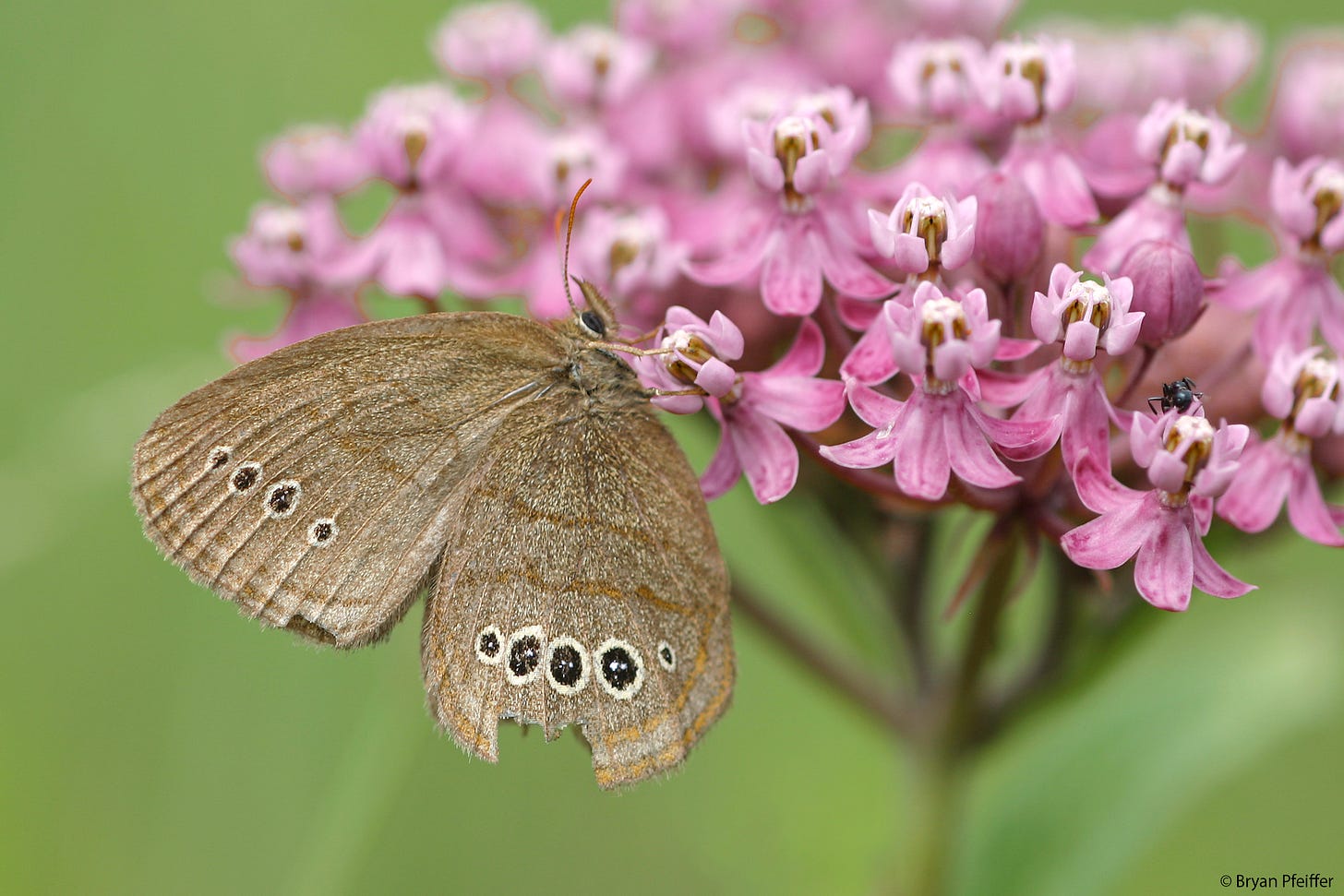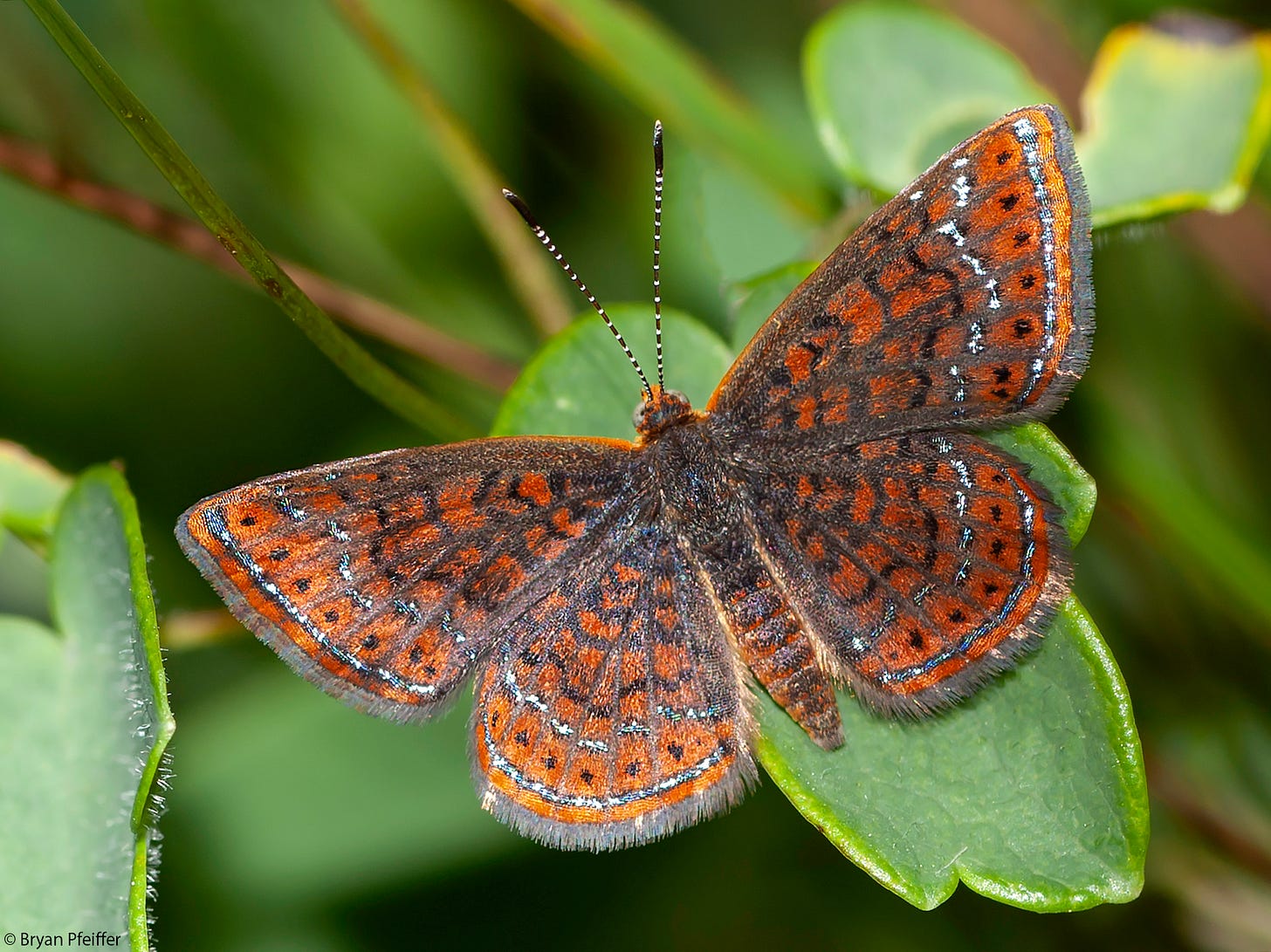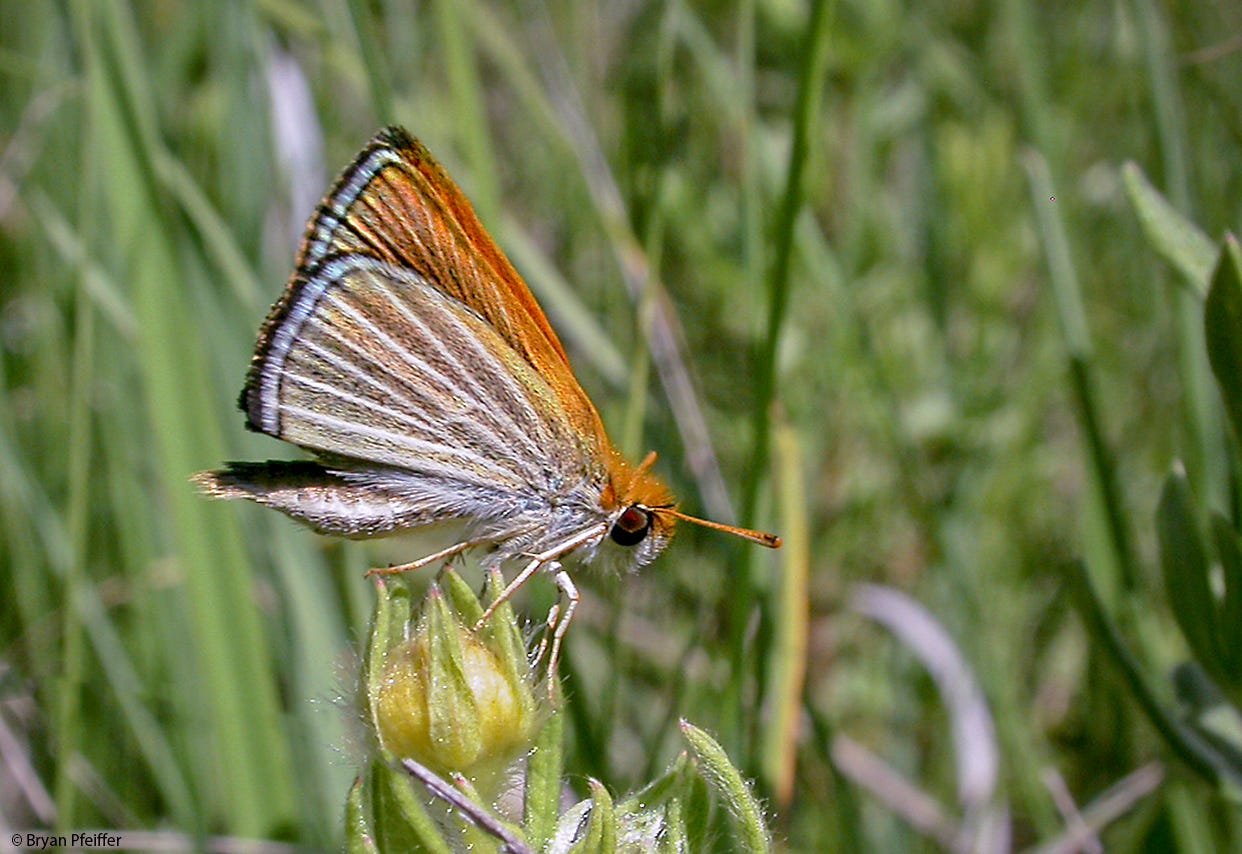The Extinction of Virtue
An imperiled butterfly and our endangered morality
TWENTY-TWO years ago, when things were about to go really bad in the prairie, I had a brush with extinction. No, not my own demise, but rather the prospective oblivion of a little butterfly named Poweshiek Skipperling (Oarisma poweshiek).
We met on a sunny day in a wet prairie fen in southern Michigan. Rather than float or flutter like most butterflies, skipperlings dart and scurry. And when one alighted on a flower bud, I dropped to my knees, admired its unusual frosty markings, and snapped the photo atop this essay.
Little did I know at the time that the Poweshiek Skipperling would go on to become one of the most imperiled animals on the planet. Despite heroic efforts now underway on its behalf, this butterfly could soon perish forever from this Earth. Those of us who’ve watched the skipperling dance across the landscape may not even get a chance to say goodbye.
But this isn’t really about me. As the Trump administration now plots to undermine the U.S. Endangered Species Act, this is more so about how a tiny butterfly can be an embodiment of loss, hope, and the human capacity for redemption.
About the size of your thumbnail, the skipperling once flew in untold numbers across the American and Canadian prairie from Michigan to Manitoba. Even so, few people have ever heard of it, let alone seen it. Fewer still may have the chance. Since I snapped that photo, the Poweshiek Skipperling, somewhat mysteriously, has all but vanished from the world. Gone from 99 percent of its previously known sites, the skipperling no longer flies in North Dakota, South Dakota, Minnesota, Iowa, Illinois, and Indiana. The only remaining Poweshiek Skipperlings cling to life at but a few sites in Michigan and Manitoba (perhaps Wisconsin) — and in captivity.
But let’s be honest about the Poweshiek Skipperling. It’s a bit player on the extinction stage. It has no big social media presence, no crowds in the streets shouting “Save the Skipperling!” If this butterfly does fade away for good, I suspect few people will mourn its passing. To busy and distracted humans, the skipperling is yet another abstraction bound for extinction, something they will never see, let alone understand or appreciate. After all, what good is a butterfly that does not tweet or titillate or turn a profit? Why save the skipperling, anyway?
The Legality of Extinction

Those of us who aspire to protect wildlife and wild places turn to well-rehearsed arguments in defense of imperiled species: rare plants might serve humanity as medicine; some of these animals are “canaries in the coal mines” alerting us to greater ecological problems; or that endangered species are part of our national heritage, no less notable than the Liberty Bell or Old Faithful. All worthy assertions, all fairly anthropocentric, and too often failures in the maelstrom of politics and public discourse.
Another strategy is to demonstrate that there’s money to be made or saved in protecting biological diversity. Ecosystems provide us with tangible “services” to which we can assign dollar values: barrier islands safeguarding communities from storm surges and flooding, for example, forests sequestering carbon and easing the climate disaster, or even the peace of mind humans gain in nature. Recognizing these “ecosystem services” is indeed another worthy policy idea — and yet largely another failure, especially now here in the U.S. What hope can there be for a butterfly in the path of a new golf course or oil industry profits?
Our laws haven’t worked so well either. The Endangered Species Act, although monumental and vital, has been an imperfect guardian of biological diversity, even before the predations of the Trump administration. The Poweshiek Skipperling is a case in point.
This butterfly’s decline was set in motion 200 years ago when settlers began turning prairies into farmland. Since then, across the skipperling’s historic range, nearly all of the native prairie has been lost, in large part to industrial agriculture, notably for corn and soybeans. Next came livestock grazing, invasive plant species, and pesticides (which kill insects after all). Taken together, it amounts to a perfectly legal decimation of a prosaic butterfly and so much of the prairie diversity and beauty going with it.
Still, in widely scattered sites across its range, the Poweshiek Skipperling somehow managed to hang on — enough so that in the late 1990s and early 2000s lepidopterists like me could find them at 100 or so remnant locations in the Upper Midwest and Manitoba. Then things went bad — fast. At site after site, the orange lights of this butterfly began to blink out like candle flames in a rainstorm. Today, Poweshiek Skipperlings, once so abundant they were taken for granted, fly at only two sites in Michigan and one in Manitoba. Even at those locations their fate remains uncertain. But why?
The research suggests two all-too-familiar suspects: new pesticides and global warming. The population crash during the past two decades coincides with increased use of a class of agricultural insecticides known as neonicotinoids. So deadly are these chemicals to insects, including beneficial pollinators, that the European Union has imposed restrictions and bans on their use. Not so in the U.S.
Global warming threatens skipperlings in too many ways. More frequent droughts, for example, not only harm butterflies directly but can deplete the quality and availability of their food — either the prairie grasses that the caterpillars eat or the flowers from which the adults sip nectar. And because Poweshiek Skipperlings overwinter as caterpillars under the protective insulation of snow, a warmer prairie’s depleted snowpack leaves them vulnerable to death by dehydration or freezing.
But here’s the policy tragedy: Virtually all the decimation of Poweshiek Skipperling was perfectly legal. It happened under Republican and Democratic administrations alike. Even if the United States ever had a true conservationist as president (which is debatable), the food we eat, the fuels we burn, and the land lost to our population growth inevitably brings collateral damage to nature— either declining abundance or outright extinction. A little butterfly might never stand a chance.
Will We Do Better?

Hope for the skipperling came in 2014, when it was listed and protected by the Obama administration under the U.S. Endangered Species Act. This butterfly’s fate now rests largely with an international partnership of researchers, land managers, field biologists, and volunteers working on the skipperling’s recovery. A crucial strategy involves breeding and raising skipperlings in captivity so that they can be released to fly at suitable tallgrass prairie and prairie fen sites. At some of these sites, the researchers have released more butterflies than existed at the time in the location’s wild population.
Although this work is inspirational and promising, it’s not yet clear whether it is too late for the skipperling — or for us. When settlers began turning prairie into farmland, they didn’t know much about threats to skipperlings or biodiversity overall. Now we know. We’re the only species on the planet with the intelligence to name a prairie, to destroy a prairie, and to know that we’ve decimated its butterflies and wildflowers and intrinsic complexity and beauty. The question now is whether we have the capacity to do better, to live in protection of nature.
Manifest destiny first pushed the Poweshiek Skipperling toward the brink. Then came the inexorable rush of humanity. Now comes our test. Because this isn’t only about one of the rarest butterflies in the world. It’s about us. It’s about fighting to preserve the Endangered Species Act, and for stronger laws protecting nature.
The Poweshiek Skipperling will never have the charisma of a Giant Panda or a Polar Bear. Nor will it gain the lofty status of a Blue Whale or a Mountain Gorilla. We nonetheless owe this butterfly existence. Otherwise, after the skipperling, when it comes to so much more nature pushed to the brink, there may be little practical or moral limitations on human excess.
What has the Poweshiek Skipperling done for us lately? Well, to be honest, not much — at least in the ways we too often measure progress. When the skipperlings are gone, a prairie looks pretty much the same. But not to me. Without this butterfly, the prairie is a prairie depleted. And so are we. Not only are we deprived of orange and frosty flames skipping across the tallgrass, we face an extinction of virtue — the loss of what it means to be human, to protect the vulnerable, even the uncharismatic, and to live more aware and responsibly in an increasingly unnatural world.
Postscripts and Skipperlings
The Poweshiek Skipperling International Partnership is at work to save this butterfly.
A beautiful eight-minute summary video, called “Life on the Brink,” from the Michigan Nature Association.
Coverage of the Trump administration’s designs on the Endangered Species act:
From an ecologist and a law professor at The Conversation
From Public Domain here on Substack
From Sara Dewey, senior staff attorney at the Environmental & Energy Law Program at Harvard Law School
Other notable conservation and ecology writers and publications here on Substack:
- at
- at
- at
- at
- at




I worked for many years to create a homegrown nature sanctuary in my former suburban home. Everyday brought new excitement with butterflies, birds, possum mommas, baby rabbits, snakes, squirrels, etc. I was describing the beauty of the many butterflies passing through to my hairdresser. replied, “what good is a butterfly, really, why should I care?”. I remember being sad but stymied by her question at the time - thanks for articulating and answering the question so well.
We humans are so blinded, unable to see the reality of our own actions. We are part of the very world we are slowly destroying, and ultimately, will cause our own demise as a result. That was a beautiful piece on a very sad topic. I got misty eyed reading it. You did good……